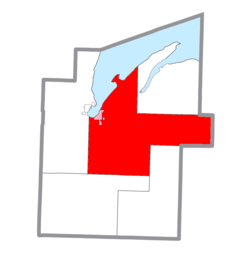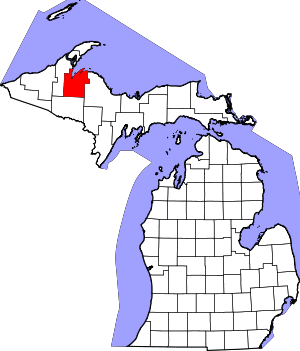L'Anse Township, Michigan
L'Anse Township is a civil township of Baraga County in the U.S. state of Michigan. As of the 2010 census, the township population was 3,843.[3] Mount Arvon and Mount Curwood, the highest and second highest points in Michigan, are located in the township.
L'Anse Township, Michigan | |
|---|---|
L'Anse Township Hall in the village of L'Anse | |
 Location within Baraga County (red) and the administered village of L'Anse (pink) | |
 L'Anse Township Location within the State of Michigan | |
| Coordinates: 46°43′41″N 88°22′18″W | |
| Country | United States |
| State | Michigan |
| County | Baraga |
| Area | |
| • Total | 269.0 sq mi (696.8 km2) |
| • Land | 247.4 sq mi (640.8 km2) |
| • Water | 21.6 sq mi (56.0 km2) |
| Elevation | 1,365 ft (416 m) |
| Population (2010) | |
| • Total | 3,843 |
| • Density | 16/sq mi (6.0/km2) |
| Time zone | UTC-5 (Eastern (EST)) |
| • Summer (DST) | UTC-4 (EDT) |
| ZIP code | 49946 |
| Area code(s) | 906 |
| FIPS code | 26-45560[1] |
| GNIS feature ID | 1626587[2] |
| Website | Official website |
History
The township has a rich and varied history as far back as October 15, 1660, with the arrival of the first white man on record, French Jesuit priest René Menard. Menard spent the winter in what is presently known as Pequaming on Keweenaw Bay, and left the area for Fond du Lac the following spring, never to be heard from again. He was followed by Father Claude in 1666.
Over the next 200 years, the Chippewa tribe populated the area, and attracted the attention of trappers and traders throughout the Great Lakes. The American Fur Company established a trading post at Assinins by a man known only as Dubay. The Hudson's Bay Company had established a post near Zeba in 1836, which operated for about 15 years. Other early settlers included trappers and missionaries.
The first mission in the area was established in 1833 by a Chippewa who had converted to Methodism and taken the name of John Sunday. The first mission was located on the east side of the bay north of L'Anse at Zeba, with a second opened at Ottawa Lake in 1835. In 1834, Daniel Meeker Chandler left Sault Ste. Marie and headed west on Lake Superior by canoe. He arrived at his destination, called "Ke-Wa-We-Non", on September 3, and began mission work for the Methodist Church on the east side of Keweenaw Bay. The following summer, Chandler began cutting timber for a proposed Native American village known today as Zeba.
In 1836, a Canadian named Peter (Pierre) Crebassa was appointed as representative trader by the American Fur Company, and moved the post from its original location on the west side of the bay to a site north of L'Anse at the present day Township Park. Crebassa married a Chippewa girl, Nancy, and they were instrumental in convincing Father Frederic Baraga to establish a Catholic mission, which he founded at Assinins on the west side of Keweenaw Bay in 1843.
When Michigan became the 26th state in 1837, the western two-thirds of the Upper Peninsula were included as a compromise (Ohio received the "Toledo Strip"). In March 1843, the legislature divided the Upper Peninsula into several counties. Three years later, in 1846, the act was amended to make all that part of the state "embraced between the north boundary of township 49, the line between ranges 37 and 38 west and Lake Superior, together with islands in said lake west of the county of Schoolcraft, shall be laid off as a separate county, to be known and designated as the County of Houghton." The new county included the present-day Keweenaw and Baraga counties, and was organized into three election precincts (townships) at Eagle Harbor, Houghton, and L'Anse. The following year, the area was reorganized into the townships of Copper Harbor, Eagle Harbor, Houghton, Portage, Algonquin, and L'Anse, and the first election took place in July 1848.
The coming of the railroad spurred growth of the village of L'Anse in 1871, which prospered for a couple of years until the Panic of 1873.
Algonquin and L'Anse townships combined in 1875 to form Baraga County, and created the townships of Arvon, Baraga, Covington, Spurr and L'Anse.
In 1896, the village of L'Anse burned to the ground, but gradually rebuilt itself into a lumber town with the arrival of the Ford Motor Company in the early 20th century.
Communities
The Village of L'Anse is the only incorporated municipality in the township. There are some unincorporated communities and historic locales:
- Alberta is on U.S. Highway 41 about 8 miles (13 km) south of the village of L'Anse.
- Herman is a farming district near L'Anse.
- Laughs Lake is an unincorporated community in the township located on Lost Lake.
- Pequaming is on a bear-shaped point projecting into Keweenaw Bay.
- Summit is a locale just south of Herman.[4][5] It was a station on the Duluth, South Shore and Atlantic Railway that opened c. 1880, 10 miles (16 km) southeast of L'Anse. It is named for its location near Mount Curwood, which until 1982 was thought to be the highest point in Michigan.[6]
- Zeba is a census-designated place located just north of the village of L'Anse.
Geography
According to the United States Census Bureau, L'Anse Township has a total area of 269.0 square miles (696.8 km2), of which 247.4 square miles (640.8 km2) is land and 21.6 square miles (56.0 km2), or 8.03%, is water.[3]
Demographics
As of the census[1] of 2000, there were 3,926 people, 1,610 households, and 1,059 families residing in the township. The population density was 15.8 per square mile (6.1/km2). There were 1,918 housing units at an average density of 7.7 per square mile (3.0/km2). The racial makeup of the township was 82.86% white, 0.18% African American, 13.68% Native American, 0.18% Asian, 0.03% Pacific Islander, 0.08% from other races, and 3.01% from two or more races. Hispanic or Latino of any race were 0.76% of the population. 25.8% were of Finnish, 9.6% German, 9.3% French and 5.2% Norwegian ancestry according to Census 2000.
There were 1,610 households, out of which 29.0% had children under the age of 18 living with them, 49.7% were married couples living together, 11.2% had a female householder with no husband present, and 34.2% were non-families. 29.8% of all households were made up of individuals, and 13.7% had someone living alone who was 65 years of age or older. The average household size was 2.35 and the average family size was 2.90.
In the township the population was spread out, with 24.0% under the age of 18, 7.2% from 18 to 24, 26.2% from 25 to 44, 25.0% from 45 to 64, and 17.6% who were 65 years of age or older. The median age was 40 years. For every 100 females, there were 93.1 males. For every 100 females age 18 and over, there were 93.1 males.
The median income for a household in the township was $33,750, and the median income for a family was $43,776. Males had a median income of $32,321 versus $21,231 for females. The per capita income for the township was $16,455. About 7.2% of families and 11.0% of the population were below the poverty line, including 13.3% of those under age 18 and 4.8% of those age 65 or over.
References
- "U.S. Census website". United States Census Bureau. Retrieved 2008-01-31.
- "L'Anse Township, Michigan". Geographic Names Information System. United States Geological Survey.
- "Geographic Identifiers: 2010 Demographic Profile Data (G001): L'Anse township, Baraga County, Michigan". U.S. Census Bureau, American Factfinder. Archived from the original on February 12, 2020. Retrieved December 24, 2013.
- Baraga County Michigan 2009 Plat Book. Farm & Home Publishers LTD. 2009. p. 28.
- "Summit, Michigan". Geographic Names Information System. United States Geological Survey.
- Romig, Walter (1986) [1973]. Michigan Place Names. Detroit, Michigan: Wayne State University Press. ISBN 0-8143-1838-X.
Further reading
- Baragaland Bicentennial 1776-1976. Baraga, Michigan: The Lumberjacks. 1976.
- 100 Years of History: L'Anse/Skanee Centennial. Ishpeming, Michigan: Baraga County Historical Society Pageant Division. 1971.
